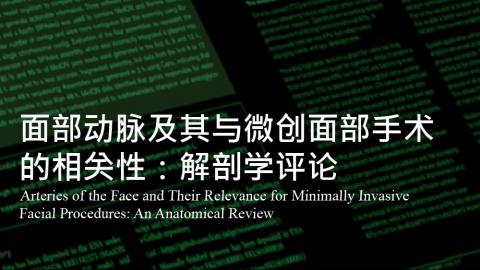
- 1972人
- 分享收藏
面部动脉及其与微创面部手术的相关性:解剖学评论
Arteries of the Face and Their Relevance for
简介
【 文献重点摘要 】
Background: The purpose of this article is to provide a comprehensive review based on images and discussion of the current understanding of the arterial supply of the face to facilitate safe minimally invasive antiaging procedures.
Methods: Contrast-enhanced computed tomographic scans of 40 fresh frozen heads from 17 male and 23 female Caucasian body donors with a mean age of 76.9 ± 13.1 years and a mean body mass index of 23.6 ± 5.3 kg/m2 were retrospectively analyzed and compared to cadaveric dissections performed in more than 400 fresh cephalic specimens.
Results: This review presents the current understanding of the facial arteries based on existing literature, direct observation from cadaveric dissection, and the dissection experience of the two authors of the study. It reveals the constant three-dimensional locations of the facial and angular arteries: mandible, modiolus, and medial canthus as compared to their unpredictable course in other facial regions. In addition, the anatomy of the ophthalmic and central retinal arteries is discussed in the context of current treatment strategies in cases of blindness following facial soft-tissue filler injections.
Conclusions: The arterial supply of the face exhibits high variability in branching patterns, course (two-dimensional), and depth (three-dimensional). Because of the lack of predictability of the vascular anatomy, it is impossible to absolutely guarantee safety when performing minimally invasive injectable procedures. Injectors should understand the potential for adverse vascular events, communicate this risk appropriately to patients, and be properly trained and equipped to treat any such complication.
背景:这篇文章的目的是基于图像和讨论对面部动脉供应的当前理解提供一个全面的综述,以促进安全的微创抗衰老过程。
方法:回顾性分析男性17例,女性23例,平均年龄(76.9±13.1)岁,平均体重指数(23.6±5.3)kg/m2的40例新鲜冰冻头颅CT增强扫描结果,并与400多例新鲜头颅标本的解剖结果进行比较。
结果:本综述基于现有文献、身体解剖的直接观察和两位作者的解剖经验,介绍了对面动脉的认识现状。它揭示了面部动脉和角动脉的恒定三维位置:下颌动脉、蜗牛动脉和内眼角动脉,与其他面部区域的不可预测的走行相比,它揭示了面部动脉和角动脉的恒定三维位置。此外,眼动脉和视网膜中央动脉的解剖学在面部软组织填充物注射后失明病例的当前治疗策略的背景下进行了讨论。
结论:面部动脉血供在分支方式、走行(二维)和深度(三维)上表现出高度的变异性。由于血管解剖学缺乏可预测性,在进行微创可注射手术时不可能绝对保证安全性。注射者应该了解不良血管事件的可能性,适当地将这种风险传达给患者,并接受适当的培训和装备,以治疗任何此类并发症。



